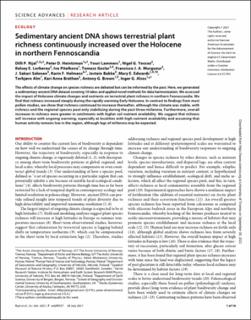| dc.contributor.author | Rijal, Dilli Prasad | |
| dc.contributor.author | Heintzman, Peter D. | |
| dc.contributor.author | Lammers, Youri | |
| dc.contributor.author | Yoccoz, Nigel | |
| dc.contributor.author | Lorberau, Kelsey | |
| dc.contributor.author | Pitelkova, Iva | |
| dc.contributor.author | Goslar, Tomasz | |
| dc.contributor.author | Murguzur, Francisco Javier Ancin | |
| dc.contributor.author | Salonen, J. Sakari | |
| dc.contributor.author | Helmens, Karin F. | |
| dc.contributor.author | Bakke, Jostein | |
| dc.contributor.author | Edwards, Mary E. | |
| dc.contributor.author | Alm, Torbjørn | |
| dc.contributor.author | Bråthen, Kari Anne | |
| dc.contributor.author | Brown, Antony | |
| dc.contributor.author | Alsos, Inger Greve | |
| dc.date.accessioned | 2021-09-10T12:42:59Z | |
| dc.date.available | 2021-09-10T12:42:59Z | |
| dc.date.created | 2021-08-26T16:39:02Z | |
| dc.date.issued | 2021 | |
| dc.identifier.issn | 2375-2548 | |
| dc.identifier.uri | https://hdl.handle.net/11250/2775245 | |
| dc.description.abstract | The effects of climate change on species richness are debated but can be informed by the past. Here, we generated a sedimentary ancient DNA dataset covering 10 lakes and applied novel methods for data harmonization. We assessed the impact of Holocene climate changes and nutrients on terrestrial plant richness in northern Fennoscandia. We find that richness increased steeply during the rapidly warming Early Holocene. In contrast to findings from most pollen studies, we show that richness continued to increase thereafter, although the climate was stable, with richness and the regional species pool only stabilizing during the past three millennia. Furthermore, overall increases in richness were greater in catchments with higher soil nutrient availability. We suggest that richness will increase with ongoing warming, especially at localities with high nutrient availability and assuming that human activity remains low in the region, although lags of millennia may be expected. | en_US |
| dc.language.iso | eng | en_US |
| dc.publisher | American Association for the Advancement of Science | en_US |
| dc.rights | Navngivelse 4.0 Internasjonal | * |
| dc.rights.uri | http://creativecommons.org/licenses/by/4.0/deed.no | * |
| dc.title | Sedimentary ancient DNA shows terrestrial plant richness continuously increased over the Holocene in northern Fennoscandia | en_US |
| dc.type | Journal article | en_US |
| dc.type | Peer reviewed | en_US |
| dc.description.version | publishedVersion | en_US |
| dc.rights.holder | Copyright 2021 the authors | en_US |
| dc.source.articlenumber | eabf9557 | en_US |
| cristin.ispublished | true | |
| cristin.fulltext | original | |
| cristin.qualitycode | 1 | |
| dc.identifier.doi | 10.1126/sciadv.abf9557 | |
| dc.identifier.cristin | 1929080 | |
| dc.source.journal | Science Advances | en_US |
| dc.relation.project | Norges forskningsråd: 250963 | en_US |
| dc.identifier.citation | Science Advances. 2021, 7 (31), eabf9557. | en_US |
| dc.source.volume | 7 | en_US |
| dc.source.issue | 31 | en_US |

